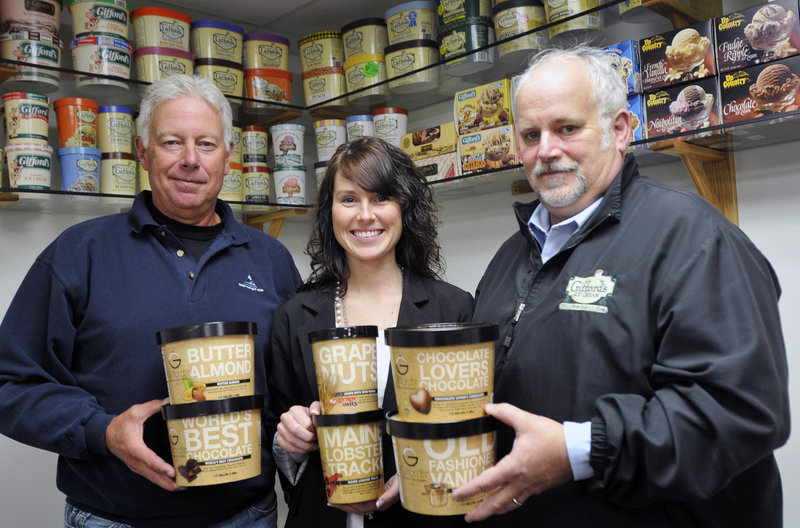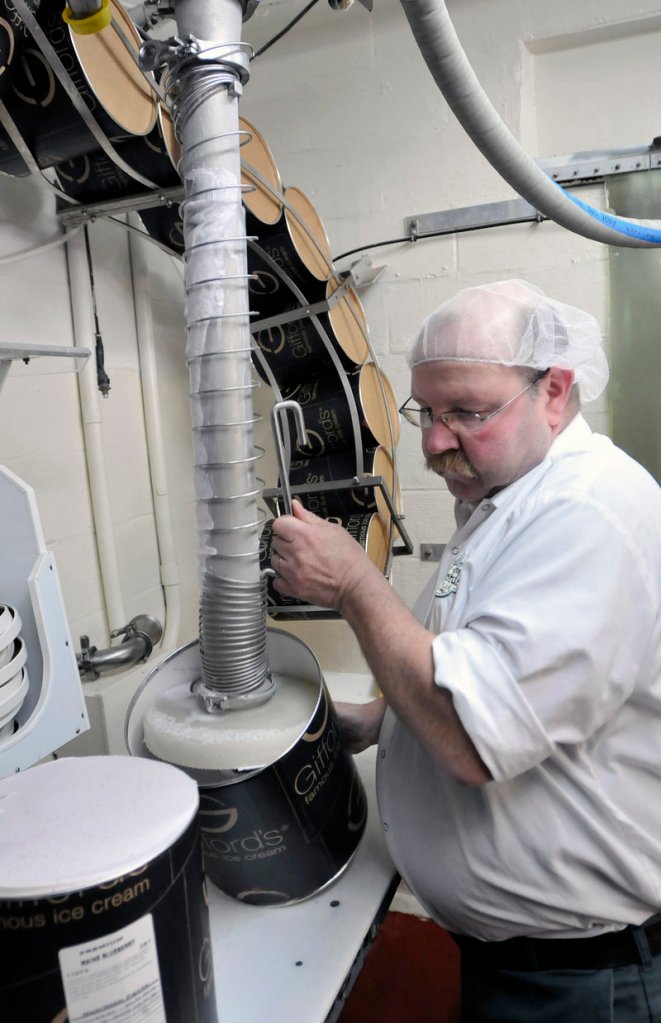SKOWHEGAN – Roughly 30 years ago, Randall Gifford left the fate of his Skowhegan dairy in the hands of two of his sons, Roger and John.
They had a choice to make: Continue the dairy business, or sell their father’s company and switch to making ice cream.
It was a big decision — at the time, Gifford’s dairy was one of the largest in Maine.
But armed with family support, heirloom recipes and top-shelf ingredients, the Gifford brothers rolled the dice, launching Gifford’s Ice Cream in the early 1980s.
Since then, sales have grown to roughly $12 million annually and Gifford’s ice cream, once sold at a single roadside stand, is now available at supermarkets and ice cream parlors throughout the Northeast.
“We were naive enough not to know what was ahead of us. We had a will to succeed and lots of drive. We were not going to fail,” said 55-year-old John, now Gifford’s treasurer.
“We went from a pretty big milk company, to a pretty small ice cream company,” added Roger, 59, Gifford’s president.
The dairy industry runs deep in the Gifford family.
John and Roger’s grandfather was a dairy farmer, and their mother, Audrey, now 84, once worked at a dairy stand.
Their father, Randall, also 84, launched his own milk delivery company in Forestville, Conn., around 1950. He also made and sold ice cream in the summer.
Randall, who was born in Portland, moved the family back to Maine when he bought Titcomb’s Dairy in Farmington in the early 1970s. He later acquired Pillsbury’s Dairy, Hunt’s Dairy and Westerly Dairy.
In the early 1980s, the Giffords shifted to ice cream production after selling the dairy side of the business to Stan Bennett of Portland’s Oakhurst Dairy.
Based in Skowhegan, Gifford’s makes up to 10,000 gallons of ice cream daily and sells roughly 80 flavors, some with names like Maine Lobster Tracks and Moose Tracks.
In the first step of the production process, milk and cream are pasteurized and mixed with skim milk powder, water and sweetener.
The mixture ages for 24 hours in storage tanks, a step that operation manager Joel Violette, a 33-year employee, said makes it sweeter and tastier.
Next, the liquid is blended with flavors — last week they made blueberry ripple — in a 400-gallon mixing tank, then pumped into one of three “continuous freezers,” where the mixture is cooled, churned and blended with air.
The ice cream, now soft like warm butter, is mixed with other ingredients like fruit or chocolate chips, before workers pack it into containers.
Next, a conveyor belt carries the containers into the “hardening room,” a freezer the size of a small apartment where thousands of gallons of ice cream cool.
Violette said this is a critical step — ice cream must be cooled quickly to minimize ice crystals.
The temperature inside Gifford’s hardening room is minus-25 degrees Fahrenheit, though fans make it feel like 60 below zero. Employees here wear thick jackets with hoods, and clothing designed for arctic temperatures, said Violette.
Inside the hardening room are steel plates filled with glycol, which Violette said pulls all warmth from the ice cream in four hours.
Gifford’s sells ice cream at company-operated ice cream stands in Farmington, Bangor, Skowhegan, Waterville and Auburn. The stands opened for the 2011 season on Friday.
In addition, Gifford’s is sold at local stores, including Hannaford Bros. and Shaw’s, and supermarkets and ice cream shops as far south as New Jersey. The company also sells a lower-cost ice cream to institutions, like hospitals and colleges.
Gifford’s has roughly 30 full-time employees, but hires an additional 100 workers during the spring and summer seasons.
Vice President of Sales Lindsay Gifford-Skilling, John’s daughter, said Gifford’s sales jumped 9 percent in 2009 and 7 percent in 2010, despite the recession. And the sales team’s 2011 target is 15 percent higher than 2010. Over the last 20 years, sales have increased an average of 6 percent or 7 percent annually, she said.
Lynda Utterback, executive director of the National Ice Cream Retailers Association, said ice cream tends to sell well even during a recession because it’s inexpensive.
“You can buy an ice cream cone for a couple of dollars. You can’t even go to a movie for that,” she said.
More than anything, weather affects the industry, Utterback said — rain tends to discourage folks from standing in line at ice cream stands.
Roger Gifford said fluctuating prices for commodities like milk, cream, sugar and cocoa also affect the business. When prices are high, he said, Gifford’s might lose money on certain flavors, such as pistachio. A quart of Gifford’s ice cream typically retails for about $4.50, while a half gallon starts at about $5.99.
Gifford’s competes with larger ice cream companies like Breyers and Ben & Jerry’s, both owned by the multinational firm Unilever, and Edy’s and Dreyer’s, owned by Nestl?Hood is another competitor.
The Giffords say quality sets them apart.
Gifford’s premium ice cream has 14 percent milk fat and is 20 percent air, which makes for a richer product, said Gifford-Skilling.
Some competing products are up to 50 percent air and contain 10 percent milk fat, the minimum required by the U.S. Department of Agriculture, she said. (Gifford’s lower-cost ice cream has the minimum 10 percent.)
Operation manager Violette said Gifford’s ingredients — Maine blueberries, imported chocolate and real vanilla extract — also make for a superior product.
Randall Gifford, retired and living in Farmington, agreed that ingredients make the difference.
“That’s where we differ in quality from the average,” he said in a phone interview from his winter home in central Florida.
“Most ice cream plants are more interested in making money than in making a decent product. They figure, if it’s sweet and cold, it’s good enough.”
Utterback, at the trade association, said a loyal customer base also helps regional companies like Gifford’s compete with major brands.
Historically, she said, ice creams were regional products, and consumers often bond with local brands early in life.
“Everyone remembers holding mom’s or dad’s hand and walking to get ice cream,” she said. “People who grew up in a certain region are very loyal to their brand.”
Jonathan Hemmerdinger can be reached at 791-6316 or: jhemmerdinger@mainetoday.com
Send questions/comments to the editors.



